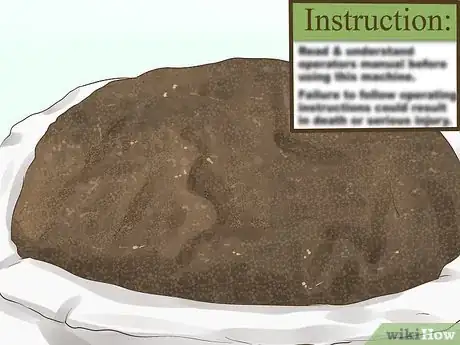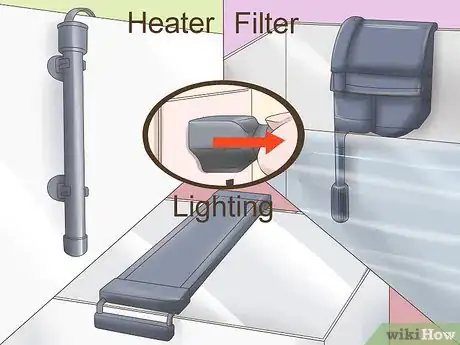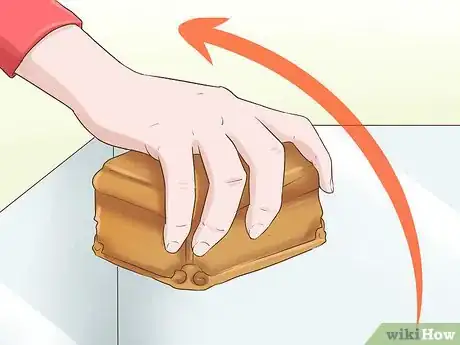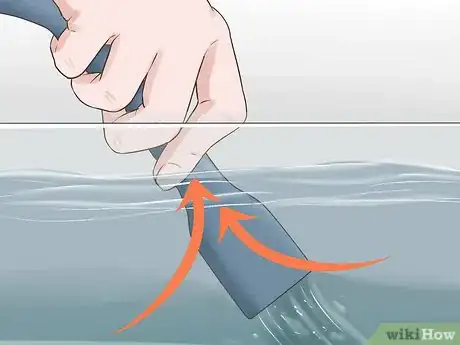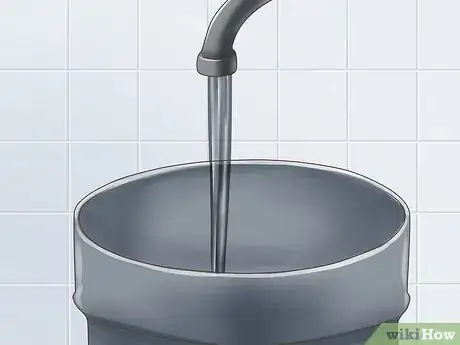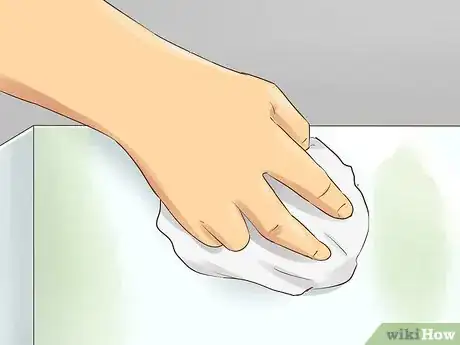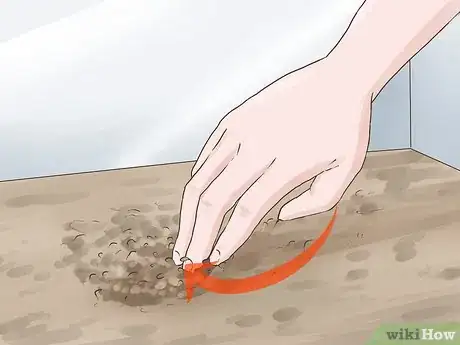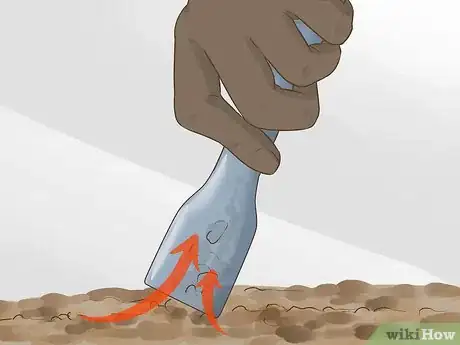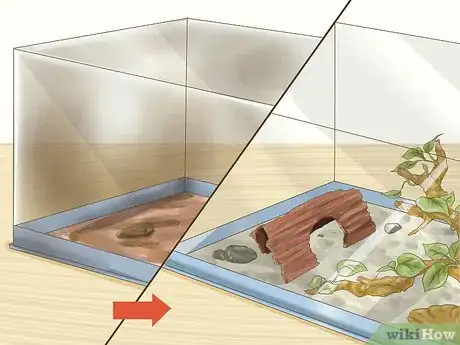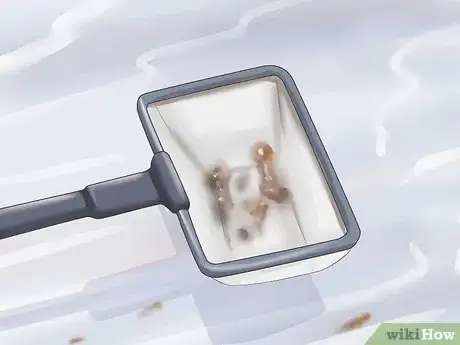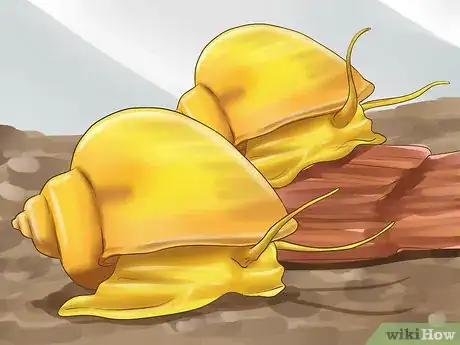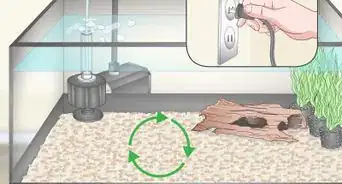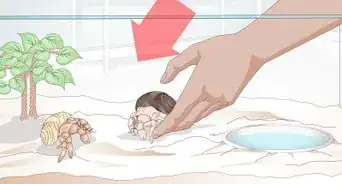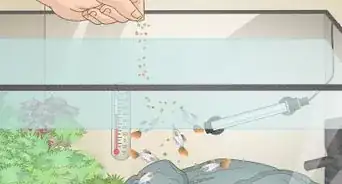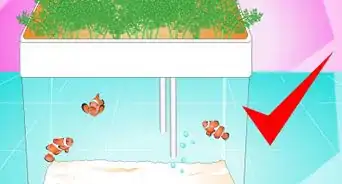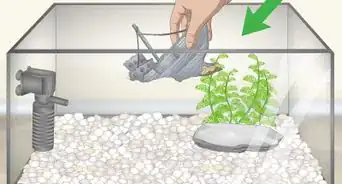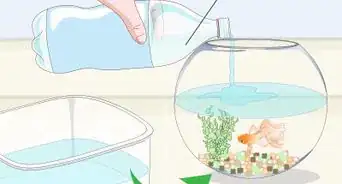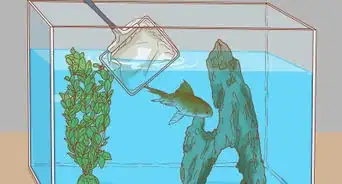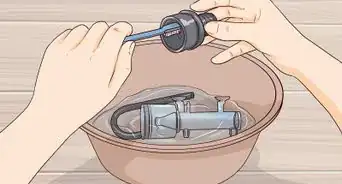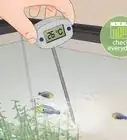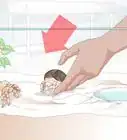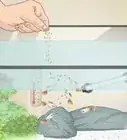This article was co-authored by Aaron Bernard. Aaron Bernard is an Aquarium Specialist and the Owner of Limited Edition Corals in Phoenix, Arizona. With over ten years of experience, Aaron specializes in aquarium maintenance, custom design, manufacture, installation, and moving. Aaron holds a BS in Biochemistry from Arizona State University, where he studied the effects of climate change on coral reefs and began to propagate his corals.
There are 10 references cited in this article, which can be found at the bottom of the page.
wikiHow marks an article as reader-approved once it receives enough positive feedback. In this case, 87% of readers who voted found the article helpful, earning it our reader-approved status.
This article has been viewed 139,957 times.
Keeping your tank clean is a critical part of maintaining the health of your fish. However, it can be a bit challenging to do a water change with a sand substrate. Start by partially emptying your tank of both water and décor. Head into the intensive cleaning by focusing on removing general debris and excessive algae growth. Keep your tank looking good by netting solid waste when you see it.
Steps
Getting Ready to Clean
-
1Know your substrate type. Not all sands are the same. If you are using standard play sand then you can rake and siphon it without too many worries regarding tank pollution. If, however, you have a specialty planting sand you’ll need to be very careful when raking as it can release ammonia and nitrates when disturbed. Read the instructions and warnings carefully on the package to find out if any special handling is necessary.[1]
- You can also visit your local aquarium store and talk with an expert who will advise you regarding your sand options. Some options, such as coral sand, are quite beautiful but can be dangerous to particular species of fish.
-
2Turn off the heater, filter, and all pumps. If they come with a switch, turn it to the off position or simply unplug all of these devices. Your fish will be fine in the short period it will take you to complete a water change and for safety reasons it is important to not have electricity running into the tank as you handle the water.[2]
- You can also take this as an opportunity to rinse out your filter pad or cartridge with cold water. You will want to do this once every two to four weeks.[3]
Advertisement -
3Remove the plants and decorations. Dip your hand into the tank water and gently remove all decorations that you would like to clean. Wash these items in warm water scrubbing gently with your hands or a soft brush to remove all algae and debris. Place the clean decorations on a lint-free rag or into a clean bucket.[4]
-
4Siphon out a portion of the water. Place your siphon into the water and begin to drain the water directly into your sink or a bucket. You need to remove between 10-25% of the water depending on the dirtiness of the tank.
- You will want to complete this partial water change and cleaning process every one to two weeks.[7]
- This dirty water does not need to be preserved and you can dispose of it immediately.
-
5Prepare replacement water. Fill a clean bucket with tap water. Add drops of a water conditioner and wait a few minutes for it take full effect. The water conditioner will remove impurities and neutralize the chlorine in tap water making it safe for fish.[8]
- Carefully read the instructions on your water conditioner bottle. The number of drops used varies as does the amount of time the water needs to sit.[9]
Removing Dirt and Debris from Your Tank
-
1Scrape off algae. Use a specialty algae scrubber or a lint-free cloth to gently rub the inside of your tank. Apply consistent and light pressure while making small circles on the surface. It is okay if pieces of algae fall to the sand as they will be siphoned up shortly.[10]
- Resist pushing too hard on your tank as it can cause damage or make the tank possibly tip over.[11]
-
2Rake your fingers through the sand. Place your fingers into the sand at the bottom of your tank. Gently push the sand from the bottom to the top. Repeat throughout the tank floor until all sand has been upturned. You will see that debris and deposits have settled on the surface of the sand.[12]
- It is sometimes helpful to go over the sand surface one time with the siphon prior to raking.
-
3Remove surface debris with a gravel siphon. Lower your siphon until it is about ½ inch above the sand’s surface. Move the siphon in a back-and-forth pattern, holding the depth level, as you pick up debris and dirt. Target any particularly large particles.[13]
- You can expect for the siphon to pick up some sand particles with this method. You can then re-rinse those particles and re-introduce them to the tank or you can throw them out. It is often a good idea to add in new sand every few weeks anyway.[14]
-
4Replace all decor. Take your time picking up the clean decorations and putting them back into the tank. You can follow the same pattern as before or you can mix it up with a new design. Make sure each piece is anchored and move around the freshly cleaned sand as needed.
-
5Pour fresh water into the tank. Replace the water that you removed by adding in the treated water to your tank. You can pour directly from the bucket, although that may disturb your tank and fish. A better option might be to use a jug to add the new water in slowly.[15]
- You can also deflect the water with a plate as it is added in which will lower the chance of damage even more.
-
6Re-activate your heater, filter, and lighting. As soon as you’ve completed the water change you can plug all of your tank appliance back in. Watch to make sure that they are operating properly before leaving the tank alone.
- You may want to leave your tank light off for a few hours following a water change. This can help your fish to relax following what may have been a stressful event.
- Check the temperature of the replacement water with a thermometer before adding it to your tank. Both water temps should be roughly the same or you risk shocking your fish.
Keeping Your Tank Clean Over Time
-
1Always rinse substrate before adding it. Get a large bucket (5 gallons) and place your new sand in the bottom. Use a sink sprayer attachment or a garden hose to spray into the sand. Keeping stirring and churning until dirt particles rise to the top. Pour this dirty water out and repeat the process. Keep going until the water is clear and your sand is ready for the tank.[16]
- Use cold water to rinse your sand, but allow it to reach room temperature before adding it to your tank.[17]
-
2Use a fine net for floating waste. Keep a small net near to your tank. Whenever you see any debris or dirt particles floating in the tank simply catch them in the net and dispose of them. This is especially important to do in the hour or so after feeding time.[18]
-
3Be careful with decoration removals. As you make alterations to your tank décor keep in mind that items can get trapped under the sand and release toxins into the water as they decay. When you remove live plants make sure to take the roots out as well. Gently dig them out of the sand.[19]
-
4Remove sections of the substrate on a schedule. It is possible to replace entire sections of your sand substrate over the course of a few months. To do this you would use a gravel cleaner to pick up the dirty sand, replacing it with new, freshly-cleaned sand.[20]
- Be aware that this method may keep your tank clean but it can also stress out your fish and diminish the production of good bacteria.
-
5Get snails. Snails can help to minimize the growth of algae in your tank, leading to cleaner sand as well. They also dig into the sand and prevent stagnation. Go to your local aquarium store and learn about the different types of snails that could suit your particular tank.[21]
Expert Q&A
-
QuestionCan I vacuum the sand at the bottom of my tank?
 Aaron BernardAaron Bernard is an Aquarium Specialist and the Owner of Limited Edition Corals in Phoenix, Arizona. With over ten years of experience, Aaron specializes in aquarium maintenance, custom design, manufacture, installation, and moving. Aaron holds a BS in Biochemistry from Arizona State University, where he studied the effects of climate change on coral reefs and began to propagate his corals.
Aaron BernardAaron Bernard is an Aquarium Specialist and the Owner of Limited Edition Corals in Phoenix, Arizona. With over ten years of experience, Aaron specializes in aquarium maintenance, custom design, manufacture, installation, and moving. Aaron holds a BS in Biochemistry from Arizona State University, where he studied the effects of climate change on coral reefs and began to propagate his corals.
Fish & Aquarium Specialist You shouldn't vacuum the sand, as this could cause unhealthy bacteria and nitrates to be released into the water.
You shouldn't vacuum the sand, as this could cause unhealthy bacteria and nitrates to be released into the water. -
QuestionWould the fish eat the snails?
 Community AnswerIt depends on what breed of fish you have. African Dwarf Frogs are able to eat a few small-sized snails, and Betta fish (more territorial/aggressive types of fish like Flower Horns) may think you're feeding them a snack.
Community AnswerIt depends on what breed of fish you have. African Dwarf Frogs are able to eat a few small-sized snails, and Betta fish (more territorial/aggressive types of fish like Flower Horns) may think you're feeding them a snack. -
QuestionI have two Axolotl and very fine sand in my aquarium. Will the gravel siphon work for that, too?
 Community AnswerNo. The sand will suck through, and you'll have a bucket of sand. I'd recommend moving the sand with your hand (one day a week will help prevent toxic gas buildup). You can use a syphon, but it does need to be at leas 3" above the top of the sand.
Community AnswerNo. The sand will suck through, and you'll have a bucket of sand. I'd recommend moving the sand with your hand (one day a week will help prevent toxic gas buildup). You can use a syphon, but it does need to be at leas 3" above the top of the sand.
Warnings
- Be careful not to overfeed your fish. This can add to tank debris and will make it necessary to complete more frequent water changes.[23]⧼thumbs_response⧽
- Moving fish out of the tank can stress them out. Try to keep your fish in the tank for weekly water changes, if at all possible.[24]⧼thumbs_response⧽
- Sand can scratch the surface of acrylic tanks. Before you rub the inside surface of your tank, check for sand particles.[25]⧼thumbs_response⧽
- Never use soap in a fish tank when cleaning.⧼thumbs_response⧽
Things You'll Need
- A gravel siphon
- Two clean buckets (one for the water and the other for the décor and plants)
- Water Conditioner
- An algae magnet or algae cleaning sponge
- A lint-free cotton rag
- A thermometer
References
- ↑ http://www.practicalfishkeeping.co.uk/features/articles/2016/10/13/how-clean-is-your-bottom
- ↑ http://www.petmd.com/fish/care/evr_fi_how-to-clean-fish-tank
- ↑ http://www.petmd.com/fish/care/evr_fi_how-to-clean-fish-tank
- ↑ http://www.petmd.com/fish/care/evr_fi_how-to-clean-fish-tank
- ↑ http://www.fish4beginners.com/cleaning/
- ↑ http://www.firsttankguide.net/waterchange.php
- ↑ http://www.firsttankguide.net/waterchange.php
- ↑ http://www.firsttankguide.net/dechlorinator.php
- ↑ http://www.firsttankguide.net/waterchange.php
- ↑ http://www.petmd.com/fish/care/evr_fi_how-to-clean-fish-tank
- ↑ http://www.fish4beginners.com/cleaning/
- ↑ http://www.practicalfishkeeping.co.uk/features/articles/2016/10/13/how-clean-is-your-bottom
- ↑ http://www.firsttankguide.net/vacuuming-aquarium.php
- ↑ http://www.practicalfishkeeping.co.uk/features/articles/2016/10/13/how-clean-is-your-bottom
- ↑ http://www.petmd.com/fish/care/evr_fi_how-to-clean-fish-tank
- ↑ http://www.cichlid-forum.com/articles/sand.php
- ↑ http://www.practicalfishkeeping.co.uk/features/articles/2016/10/13/how-clean-is-your-bottom
- ↑ http://www.practicalfishkeeping.co.uk/features/articles/2016/10/13/how-clean-is-your-bottom
- ↑ http://www.practicalfishkeeping.co.uk/features/articles/2016/10/13/how-clean-is-your-bottom
- ↑ http://www.practicalfishkeeping.co.uk/features/articles/2016/10/13/how-clean-is-your-bottom
- ↑ http://www.ratemyfishtank.com/blog/establishing-up-a-clean-up-crew-in-your-saltwater-aquarium
- ↑ https://en.aqua-fish.net/articles/advantages-aquarium-sand-instructions-discussion
- ↑ http://www.firsttankguide.net/vacuuming-aquarium.php
- ↑ http://www.petmd.com/fish/care/evr_fi_how-to-clean-fish-tank
- ↑ http://www.cichlid-forum.com/articles/sand.php
About This Article
To clean a fish tank with sand, start by turning off the heater, filter, and pumps and removing all the plants and decorations. Next, siphon out 10-25% of the water, depending on how dirty it is, and prepare the replacement water by filling a clean bucket with tap water and adding drops of water conditioner to it. While the water is setting, use a lint-free cloth to scrape any algae off the glass. Then, rake your fingers through the sand, and use a gravel siphon to remove the debris that settles on the surface. To learn how to keep your tank clean over time, keep reading!
